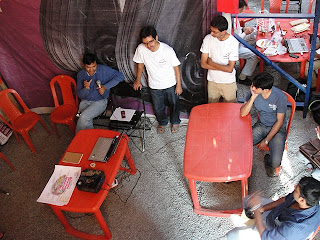
Moreover, once the construction work is done, the workers usually move on to another destination and hence the family has to move along. This does not allow a child to settle down in one place. And the obvious fact, that parents do not have the necessary financial means to send their kids to study.
Just when i thought all was lost for these children, i came across an NGO named HOPE Foundation which is renowned globally and has it's sister concerns in India in the form of Field Partners. HOPE foundation has an average of about 10 training centers in most metros across India. These centers are mostly funded by corporate giants such as EMC Square, Wal Mart etc.
HOPE Training centers are set up with the primary aim to provide Vocational Training, Spoken English and specific women empowerment courses such as tailoring. They offer these courses at a very nominal rate for those who can afford it and for the ones who cannot, the fee is absorbed by the NGO. HOPE foundation employs one trainer for each course.
I visited one of their centers at Yeshwanthpur, Bangalore, which is roughly 25 kms away from the central part of the city. The training center is nestled among an array of houses in narrow lanes, with literally just a foot separating every house.
I reported at 10.00 in the morning, just in time to interact with the first batch of students attending their vocational classes. These students got to work straightway. The guys started working on Word, Excel, PowerPoint while the girls mostly worked on their typing skills with a specially designed software to guide them.
I was shortly joined by the director of HOPE Foundation Bangalore, Mr. Joseph who introduced me to the students and they in turn introduced themselves.
What was my purpose of this visit?
While talking to Mr.Joseph the previous evening, i was told about the courses being taught. The courses included computer fundamentals, MS Office Suite, Tally etc, i decided to talk to them about the power of the internet.
So, i spoke to the students about the importance of using the internet to empower their skills, build their knowledge and how if one could specialize on internet searches and data collection. It would not only open their doors to mainstream work but also a chance to self educate.
I shared instances of companies who look for specific individuals who can source data. I introduced them to wikipedia and google. Though they are not well versed with english, the spoken english classes help them in staying in touch.
I moved on to the tailoring section, where girls of the age group of 16 -19 were learning tailoring taught by a volunteer who is a housewife at a nearby locality. She volunteers to teach tailoring here every day. Most of these girls are daughters of Daily laborers and some of them have even abandoned their daughters and wives. HOPE foundation is providing tailoring classes so they can work at factories so support themselves while their mothers do domestic chores at various houses.
My Assessment of the impact created by HOPE
The idea is very logical indeed. To provide short and specific courses and enhancing their computer skills as their stay may not be permanent. While their parents may work at a construction site for 5 months, the kid here can learn how to type, use excel and make clothes. This is an initiative that can go a long way.
Moreover, the students are enthusiastic and eager to learn, provided a platform given to them to excel. On interacting with them, i learn that they are well aware of the IT boom, and how it is a necessity to learn computers. Moreover, Students who have done courses here have been picked up by companies for data entry and accountant jobs in the past. So, there is a lot of HOPE for migrant/nomadic children.
The Future, the Challenges and the Solutions
On having completed a 3 hour interaction with the students, Mr Joseph and I sat down to discuss what the future holds for HOPE foundation and it's students. Mr Joseph believes that a lot can be achieved if certain challenges are tackled.
1. Ensuring student interests are kept alive
Some of the students, he points out, attend classes for a week or so and do not turn up due to lack of interest and deviation largely due to their teenage.
2. Finding more pockets such as Yeshwanthpur
Mr. Joseph wants to create more centers close to migrant settlements and hence generate interests among any children who would be keen to learn.
3. Creating Jobs
These individuals will be far more confident and eager once they know there is a secure job to be had on learning the course. Hence, Mr. Joseph intends to tie up with job providers to provide suitable jobs to the students.
The Solutions
1. My suggestion to Mr. Joseph was to tie up with micro credit organisations to help fund the education of these individuals. Micro credit will bring in more responsibility and with the money, HOPE foundation can also be self sustainable. With it will bring more trainers and facilities.
2. Identify market places for clothes. Since the girls learn to make dresses, if one could optimize their manufacturing, through micro credit again, it would benefit them to a great extent.
3. Introduce more courses. Such as Sales & Marketing. It will broaden their perspective and also increases their chances for finding more jobs.
4. Mr. Joseph also spoke about the need to network with more NGO's who are doing similar if not complimentary work.
CONCLUSION
Overall, my interaction with the students at HOPE foundation was very insightful. Gives people like me a chance to explore opportunities in social development. An impact both ways has been created!



